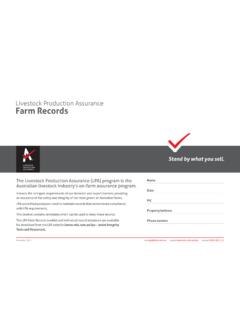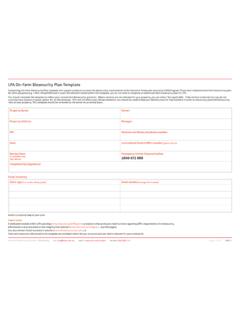Transcription of LIVESTOCK PRODUCTION ASSURANCE GUIDEBOOK
1 LIVESTOCK PRODUCTION ASSURANCE GUIDEBOOKF ebruary 2021 Stand by what you sellEmails from NLIS database PIC reconciliation Check records againstNLIS databaseLivestock movements recorded in the NLIS databaseApply NLIS devicesto LIVESTOCK Order NLIS devicesMaintain your online NLIS account LPA auditsMaintain thorough recordsManage property & LIVESTOCK to LPA standardsAccess LPA NVDsLPA accreditationMaintain your online LPA account LPA NVDs LPA and NLIS recordsProperty IdentificationCode (PIC)Identification &TraceabilityOn-farmassurance Figure 1. Australia s red meat integrity system LIVESTOCK PRODUCTION ASSURANCE GUIDEBOOKFOREWORDP eople who enjoy Australian red meat trust that it s safe to eat, ethically produced and high quality. The integrity system that underpins this trust supports the premium prices and positive international reputation of our red meat. The national LIVESTOCK PRODUCTION ASSURANCE (LPA) program is an independently audited, quality ASSURANCE program that is a foundational component of the Australian red meat integrity system.
2 Working in conjunction with the National LIVESTOCK Identification System (NLIS), LPA provides evidence of LIVESTOCK history and on- farm practices along the value LPA producers choose to make a personal commitment to adhere to specific on- farm management practices that are set out in the LPA rules and standards. Being LPA-accredited provides producers with an official stamp of quality for their red meat products. Seven elements make up LPA:1. property risk assessment2. safe and responsible animal treatments3. stock foods, fodder crops, grain and pasture treatments4. preparation for dispatch of livestock5. LIVESTOCK transactions and movements6. biosecurity7. animal accreditation gives access to LPA National Vendor Declarations (NVDs), which are required for any movement of stock to processors, saleyards or between properties if they have different property identification codes (PICs).
3 Recent upgrades to the LPA program mean producers can now store all records necessary for LPA accreditation electronically within their LPA accounts, where templates for essential LPA records can also be accessed. Property risk assessments and biosecurity plans can now be fully completed and saved online in a digital format. Further program updates have enabled random LPA audits to be conducted remotely when required. Utilising the new electronic document storage, producers can provide all requested documentation to the auditor to complete the audit remotely. I encourage producers to read through this GUIDEBOOK . It provides key information and practical advice on how to demonstrate compliance with the LPA rules and standards. The GUIDEBOOK complements the training available at LPA Learning, as well as the information available on the ISC website. The ISC Helpdesk is available on 1800 683 111 for further assistance.
4 LPA-accredited producers implement best practice for the safe and ethical PRODUCTION of red meat and can provide the evidence to demonstrate this. LPA is the quality ASSURANCE tick producers need to stand by what they Jane Weatherley CEO, Integrity Systems Company February 2021 Stand by what you sell 1 FOREWORD | | ISC Helpdesk 1800 683 1112 LIVESTOCK PRODUCTION ASSURANCE GUIDEBOOKCONTENTSFOREWORD 11. ABOUT LPA WHAT IS LPA? .. THE SEVEN ELEMENTS OF RECORD KEEPING .. AUDITING LPA ..52. MEETING LPA REQUIREMENTS PROPERTY RISK ASSESSMENT .. SAFE AND RESPONSIBLE ANIMAL TREATMENTS .. FODDER CROP, GRAIN AND PASTURE TREATMENTS AND STOCK FOODS .. PREPARATION FOR DISPATCH OF LIVESTOCK .. LIVESTOCK TRANSACTIONS AND MOVEMENTS .. BIOSECURITY .. ANIMAL WELFARE ..143. LPA ACCREDITATION 164.
5 LPA NATIONAL VENDOR DECLARATION (NVD) 185. GLOSSARY OF TERMS 206. TOOLS AND RESOURCES 22 NEED TO KNOW MORE?..221. ABOUT WHAT IS LPA?The LIVESTOCK PRODUCTION ASSURANCE (LPA) program is the Australian LIVESTOCK industry s on- farm ASSURANCE program covering food safety, animal welfare and biosecurity. It provides evidence of LIVESTOCK history and on- farm practices when transferring LIVESTOCK through the value separate but complementary elements make up the LPA program. Participation in the program is voluntary. Producers who choose to become LPA-accredited commit to carrying out on- farm practices to support the integrity of Australian red part of the LPA program, an LPA National Vendor Declaration (NVD) is required for all LIVESTOCK movements, including property to property, through saleyards, direct to processors and to feedlots, and to the live export trade. It is the main document behind Australia s reputation as a reliable supplier of safe and ethically produced red meat to domestic and international is administered on behalf of industry by the Integrity Systems Company, a wholly owned subsidiary of Meat & LIVESTOCK Australia (MLA).
6 AUS-MEAT Ltd carries out independent audits of LPA-accredited DOES LPA MEAN FOR THE LIVESTOCK PRODUCER?LPA is a voluntary industry program, however the majority of meat processors require LIVESTOCK to be sourced from LPA-accredited properties. Producers who become LPA-accredited commit to carrying out specific on- farm practices in order to fulfil their responsibility to produce red meat that is safe, ethically produced and with due consideration for biosecurity. When LIVESTOCK are transferred from a property, LPA-accredited producers or those responsible for the management of the LIVESTOCK declare on the LPA NVD (or eNVD) to say they have met the requirements of the LPA is also a requirement that LPA producers source LIVESTOCK from other LPA-accredited producers. All LPA-accredited producers may be THE SEVEN ELEMENTS OF LPALPA-accredited producers must meet specific requirements for each of the seven elements of LPA.
7 These elements are:1. Property risk assessmentsProducer responsibility: to minimise the risk of LIVESTOCK being exposed to sites that are unacceptably contaminated with persistent chemicals or physical Safe and responsible animal treatmentsProducer responsibility: to ensure animal treatments are administered in a safe and responsible manner that minimises the risk of chemical residues and physical Stock foods, fodder crops, grain and pasture treatmentsProducer responsibility: to minimise exposure of LIVESTOCK to foods containing unacceptable chemical contamination and guarantee LIVESTOCK are not fed animal Preparation for dispatch of livestockProducer responsibility: to ensure LIVESTOCK are fit for transport, and minimise the risk of stress and contamination of LIVESTOCK during assembly and LIVESTOCK transactions and movementsProducer responsibility: to ensure traceability requirements, with respect to treatments or exposure to food safety hazards, have been fulfilled for all LIVESTOCK movements between farms and feedlots, and including to slaughter and live BiosecurityProducer responsibility: to develop and maintain a documented farm biosecurity plan and to implement effective biosecurity practices in their on- farm Animal welfareProducer responsibility: to ensure handling of LIVESTOCK is consistent with the requirements of the Australian Animal Welfare Standards and Guidelines for cattle, sheep or goats (as applicable).
8 Stand by what you sell 3 1. ABOUT LPA RECORD KEEPINGWhen you tick the box on your LPA NVD, you are guaranteeing your on- farm practices meet LPA requirements, and your declaration must be backed by accurate farm records. Accredited producers must ensure that LPA NVDs and other records are retained for a minimum of three years, or in accordance with state legislation, or for the time of the LIVESTOCK on a specific property, whichever is are required to keep good records to demonstrate compliance with all the LPA requirements. The records substantiate all claims made on the LPA need to keep records on chemical usage, fodder feeding, stock movement and treatment, disease and management activities, and property risk assessment. They also need a farm biosecurity plan and records of any animal welfare training keeping must be detailed, accurate, legible and accessible. Producers should be able to easily check key food safety details, such as when LIVESTOCK were most recently treated, whether they are outside export slaughter intervals and withholding periods, and if they can be sent to market for human SHOULD RECORDS BE KEPT?
9 There is no perfect formula for record keeping. Some producers find that keeping clear notes in a diary works well for them, others use electronic spreadsheets. All records can now also be stored in the Record Keeping section of producers LPA accounts for ease of access. Regardless of the method, it is important that all relevant management activities are accurately and clearly aspects of management that should be recorded include: yProperty risk assessment record any possible contaminated sites, the risk identified, results received (if soil samples were conducted) and a description of how the site is managed to eliminate the risk of LIVESTOCK contamination. yLivestock treatments including date, identification of mob, number of stock, product, batch number, expiry date, withholding period (WHP)/export slaughter interval (ESI) and date safe for slaughter. yGrain and fodder treatment record including date, silo/storage identification, amount, product, batch number, expiry date, WHP/ESI and date safe for use.
10 YCrop, pasture and paddock treatment record including date, paddock identification, area, product, batch number, application rate and method, expiry date/date of manufacture, WHP/ESI, and the date paddocks are safe to graze. yLivestock feeding record including date, commodity vendor declaration (CVD) number, origin of feedstuff, description of feedstuff, amount, storage location, identification of LIVESTOCK fed and time of feeding (start and finish dates). yRecord of purchased or introduced LIVESTOCK keeping copies of the LPA NVD from LIVESTOCK you receive records the date, LPA NVD number, number of stock, identification, breed, sex, age, agent/sale, vendor (name and address) and property identification code (PIC). yRecords of LIVESTOCK sold keeping a copy of the LPA NVD records the date, LPA NVD number, number of stock, identification, breed, sex, age, purchaser/agent/sale, date and time of yarding, transport company and vehicle registration number.




